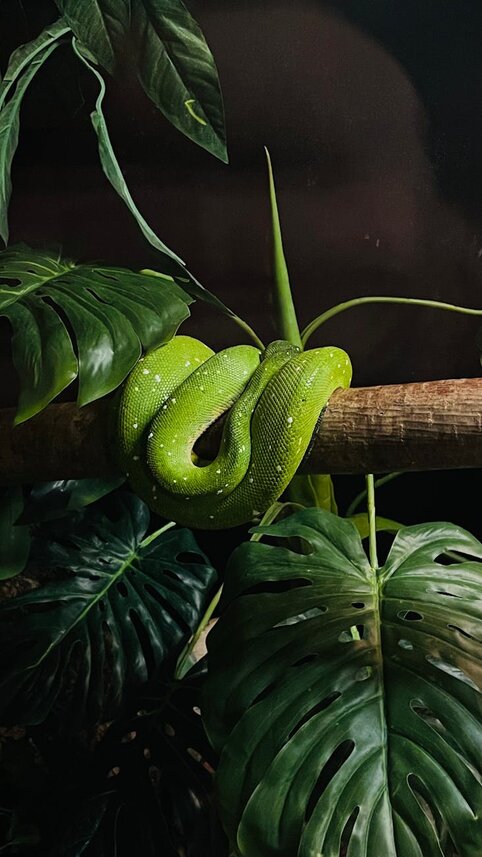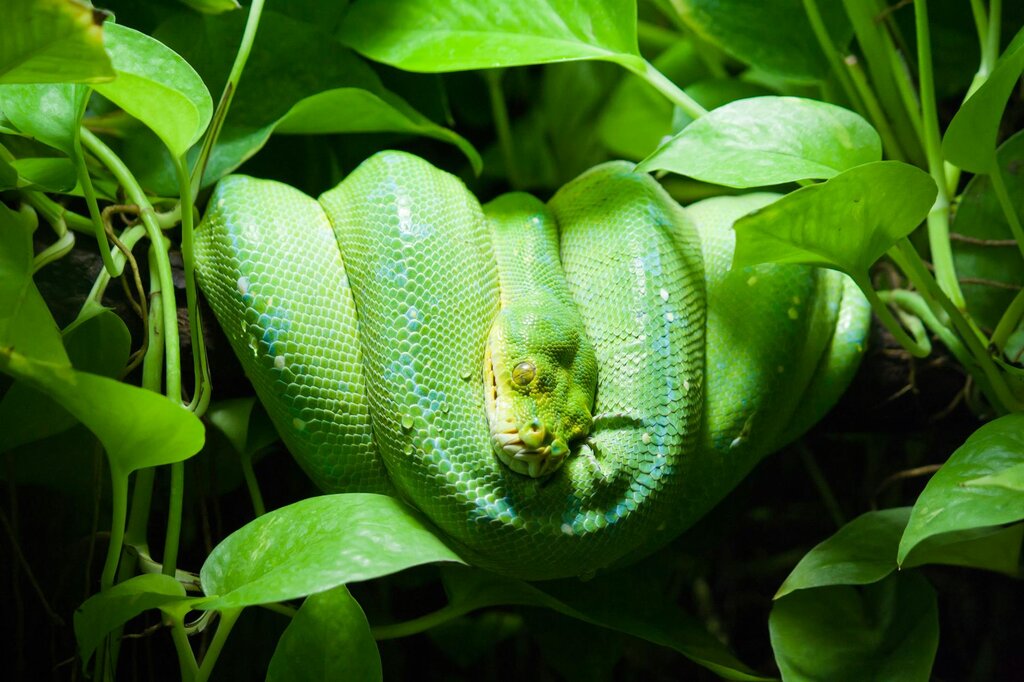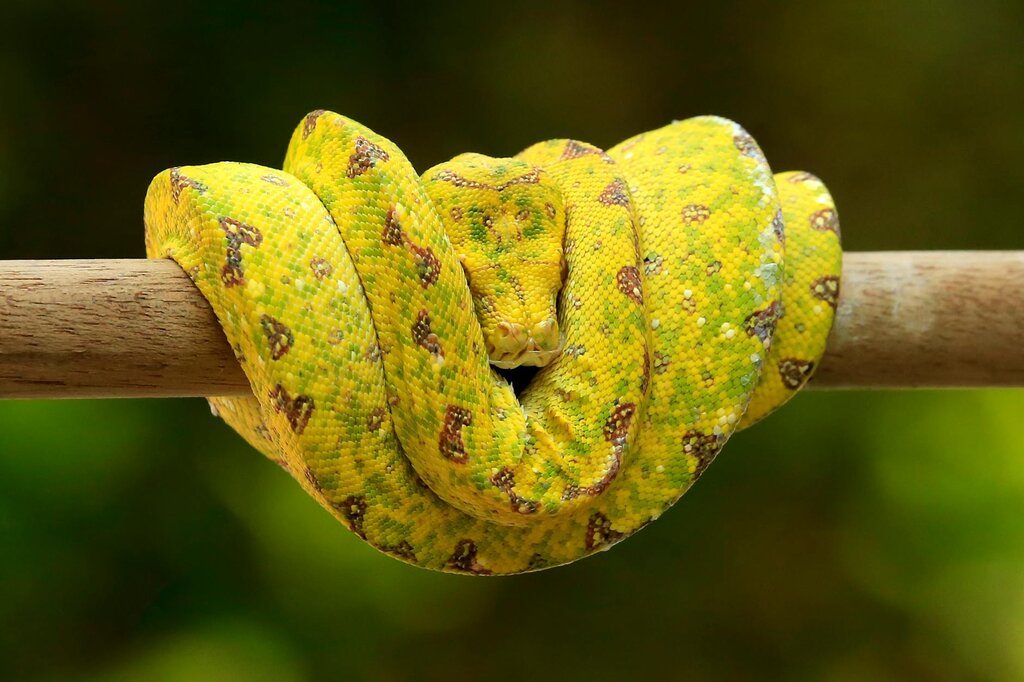Last Updated: 30/05/2025
Green Tree Python Guide
A vet's guide to keeping green tree pythons in Australia.
Author: Dr Nicole Wynne BSc BVMS MANZCVS (Unusual Pets)
Reading Time: 17 minutes - medium read
The green tree python (Morelia viridis) stands out like a jewel due to their beautiful, striking colours and patterns. The green tree python lives in the rainforests of Queensland, New Guinea, and Indonesia, and they require tropical conditions to thrive in captivity. While green tree pythons are not large snakes, reaching up to 2 metres in length with a slender body, their stunning colouration makes them a satisfying reptile to keep.
However, bringing a piece of the jungle to keep in your living room does come with some challenges. These snakes are only suitable for experienced keepers due to several factors. They have very particular enclosure and husbandry requirements due to their rainforest habitat, and they become sick very quickly if these requirements are not met. They are also notorious for being temperamental and difficult to handle. You should only consider keeping green tree pythons if you have already kept more challenging species successfully, such as Carpet or Diamond pythons. The experience will help with handling and feeding a snake that is more prone to striking, as well as troubleshooting any enclosure issues you may come across.
Is a Green Tree Python the right fit for you?
Reptile licensing requirements
All pet reptiles require a reptile keeping licence in Australia, and these differ from state to state, so ensure that you check your local requirements before getting any pet reptile. For Green Tree pythons, the licensing requirements are generally aimed towards intermediate keepers.

Preparing for your Green Tree Python

After getting your licence, the next step is putting together an enclosure for your python. As a tree-dwelling python, your snake will need a minimum of a 60 cm long by 90 cm high enclosure. Although you may be getting your snake as a juvenile, get an enclosure that suits an adult straight off, as it will save you from having to upgrade in the future. If your snake is still very small, you can house them in a plastic box within the main enclosure, which will allow you to keep the same heating and lighting system. An enclosure for a green tree python also needs to be made out of top quality materials, as it must be able to insulate well to reduce the load on the heating system. Extra insulation can be added with commercial insulating material or styrofoam as long as your snake cannot access it.
Green Tree Python checklist
Caring for your Green Tree Python

Handling green tree pythons
Regular, gentle handling is the key to helping your snake feel comfortable being handled, reducing the likelihood of your snake striking or biting. Green tree pythons may never become easy to handle, but most will become amenable to short periods of handling. Snakes can be handled up to twice a day, but ensure that each session does not last longer than your snake's comfort. In the beginning, handling sessions should last no more than 10 minutes.
It is imperative that green tree pythons be handled gently, slowly, and not restrained excessively to ensure that all handling episodes are a positive experience. Green tree pythons are more likely to become difficult to handle and aggressive after negative experience.
Approach green tree pythons from below, and ensure that they are not surprised. Always support their entire body weight, and allow them to come to you.
Signs of comfort include slow, deliberate movements, and regular tongue flicks. Tongue flicks are your snake's way of assessing their surroundings by smell, and slow, regular flicks indicate that your snake is curiously figuring out what's going on.
Signs of discomfort include rapid movements or your snake trying to escape into a dark place, such as a sleeve. Rapid, irregular tongue flicks may indicate that your snake is unsure or concerned about what is happening.
Never allow children or people inexperienced with reptiles to handle your snake unsupervised, as injury or escape may occur. They can be surprisingly fast when they're worried!
Natural sunlight for pythons
Regular exposure to natural sunlight is good for all reptiles, and this can be a positive handling experience for you and your snake! On sunny days where it is not too cold, it can be enjoyable to sit outside with your snake and a good book. Ensure that your snake can't get out of the area easily, and can't get away and hide or become lost.
At least an hour a week is a good minimum for natural sunlight, and there's no such thing as too much natural sunlight for Australian reptiles.
Snake shedding
All snakes will shed regularly, and young snakes may shed as often as every 3 weeks when they are growing rapidly. Signs that your snake is going into shed include duller colouration, behavioural change, and cloudy eyes. The cloudy eyes are the "spectacles", or clear scales over the eyes, starting to separate from the new scales underneath in preparation for shed.
If it looks like your snake is preparing to shed, the best thing to do is ensure that the water source has been freshly cleaned and refilled, ensure that the temperature is optimal, then leave your snake alone until they have finished shedding. This includes stopping feeding and handling. If your snake is due for a feed, they can be fed after the shed is complete.
Handling or feeding your snake when they are coming into shed is stressful, and it can also lead to dysecdysis, or a pathological/abnormal shed where the shed doesn't come off in one piece. If you are concerned your snake hasn't shed properly, book a vet visit, and do not attempt to peel off any shed. This may make the problem worse.
Finally...
And finally, the most important thing to remember when starting your reptile-keeping journey - enjoy! Reptiles are unique, interesting pets that have a lot of joy to give, and individuals will develop their own special personalities as time goes on. Pythons are rewarding pets, and many will become friendly and interactive, and learn to recognize their keepers as they grow.
Further Reading
Want to read more? Check out our other articles:
Beginners Guide to Reptile Care
5 Reptile Facts for People Who Aren't Herpetologists
History
Our experts continually monitor the health and wellness space and we update our articles when new information becomes available.
Wed Mar 27 2025
Edited by Dr Teagan Lever BVSc (Hons)Dr Nicole Wynne BSc BVMS MANZCVS (Unusual Pets)
Veterinarian, MANZCVS (Unusual Pets)
Dr. Nicole graduated from Murdoch University in WA in 2014, and immediately started working in exotics-only practice. She was also one of the few vets in Australia that would routinely see venomous snakes ranging from death adders to tiger snakes. Although Dr. Nicole enjoys seeing all exotic pets, her absolute favourite are rabbits. She passed her Australian and New Zealand College of Veterinary Scientists Membership (MANZCVS) exam in unusual and exotic pets in 2021.

